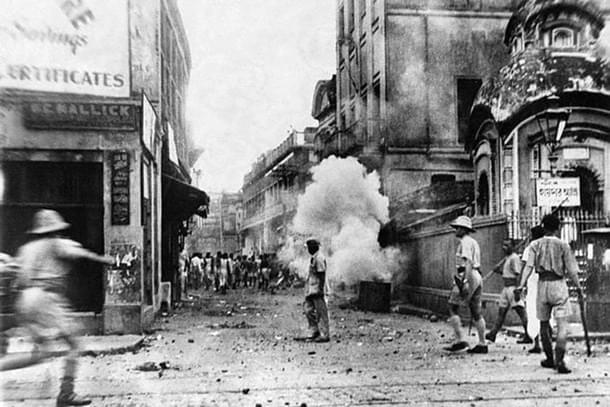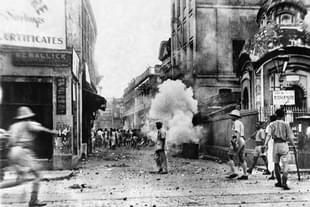West Bengal
How Pakistan Engineered Communal Riots In Kolkata Exactly 60 Years Ago
Jaideep Mazumdar
Jan 15, 2024, 05:26 PM | Updated 05:25 PM IST
Save & read from anywhere!
Bookmark stories for easy access on any device or the Swarajya app.


Exactly 60 years ago, in early-January 1964, Calcutta (as Kolkata was known then) was engulfed in communal riots that claimed the lives of an estimated 500 people, many of them Hindus.
Communal tension had been rising in Calcutta, as well as the rest of Bengal and some other parts of the country, as reports of the horrific genocide of Bengali Hindus started pouring in from East Pakistan (now Bangladesh) (read this).
The attacks on Hindus in East Pakistan were triggered by the theft of a relic from Hazratbal shrine in Kashmir. Pakistan blamed Hindus for the theft and called for revenge against Hindus of that country.
Tens of thousands of helpless and traumatised Hindus, many with festering wounds, started pouring into Bengal from East Pakistan. Their ghastly accounts of the attacks on Hindus — murders, rapes, abductions, forcible conversions to Islam and worse — angered many Hindus in Bengal.
The Pakistani Deputy High Commission in Calcutta hatched a sinister plot to provoke Muslims of the city to attack Hindus.
The Pakistani deputy high commissioner, Ziauddin Ahmed, his secretary Nasim Ali Mirza, and other officials of the Pakistani mission in Kolkata met some prominent Muslim religious leaders of the city.
The Pakistanis told the Muslim religious leaders that even though India had claimed that the Hazratbal relic had been recovered and the thieves arrested, the recovered relic was a fake one.
The Pakistani diplomats in Calcutta also urged Muslims of the city to complete the ‘unfinished business of 1946’.
The reference was to the Muslim League’s diabolic call for ‘Direct Action Day’ in August 1946 which led to widespread riots in Calcutta.
Muslim mobs, provoked by incendiary and hateful speeches (against Hindus) by then Bengal ‘Prime Minister’ Huseyn Shaheed Suhrawardy (also known as the ‘butcher of Bengal) and other Muslim League leaders, launched a genocide against Hindus of the city on 16 August 1946.
Their objective was to drive away Hindus from Calcutta and make it a Muslim-majority city. That would have strengthened the league’s demand that Calcutta be made part of East Pakistan.
The league’s sinister gameplan failed when Hindus started organising themselves and launched a counter-offensive under the leaders like Gopal Mukherjee (read this) and some others.
Even though Pakistan failed to take Calcutta in 1946-1947, it never gave up on its infernal plan to make that a reality. Realising that the Hazratbal incident could be used to incite Muslims in Calcutta against Hindus and cleanse the Hindu-majority city of its kafir inhabitants, the Pakistani Deputy High Commission set in motion its evil plan.
The Pakistani mission in Calcutta deputed agents — many Muslim criminals of Calcutta were then on its payrolls — to incite the Muslims.
There are many accounts of the Pakistani mission’s involvement in the 1964 communal riots in Calcutta.
Eminent historian and former vice-chancellor of Calcutta and Jadavpur universities, in a paper titled "The 1992 Calcutta Riots in Historical Continuum: A Relapse Into Communal Fury?" (Modern Asian Studies, Vol 34, No, 2 — May 2000) wrote that “the Deputy High Commissioner of Pakistan in Calcutta along with his officials frequented the city’s Muslim areas reportedly to incite communal feelings among their co-religionists”.
Das, a well-respected academic, wrote in the paper that Calcutta Police suspected the Muslim slum-dwellers of Central Calcutta were provided firearms by “Pakistani instigators”. Significantly, he said, many Muslims of Calcutta raised ‘Pakistan zindabad’ slogans
Das cites intelligence reports and news items published in papers, primarily the Anandabazar Patrika, to say that “rumours of West Bengal being incorporated into East Pakistan also caught the mind of a section of Calcutta Muslims, and drove them astray”.
These rumours, according to intelligence reports dating back to that period, were circulated by the Pakistani Deputy High Commission in Calcutta.
“The purpose was to create an impression among Muslims here (West Bengal) that this province would become part of East Pakistan soon and, hence, the Muslims should start attacking Hindus to drive them away from this province and make it a Muslim-majority province,” said chronicler Sudhangshu Mitra, who has studied the 1964 riots.
The Chain Of Events In Calcutta
As Hindu refugees started pouring in to Bengal from East Pakistan and newspapers started publishing the horrific tales of killings, rapes and loot that they carried with them, Hindus of Bengal were incensed.
This anger resulted in a small incident of Hindus pulling down a few makeshift shops belonging to Muslims in the Sealdah area of central Calcutta on 8 January evening. No Muslim was, however, hurt and a large number of Hindu traders of the area prevented the miscreants from attacking more Muslim shops in the area.
But the Pakistani mission and its agents in the city spread wild rumours that Muslims had been killed and their properties torched in Sealdah.
The next day (9 January), meetings were held in various parts of Calcutta to protest the genocide of Hindus in East Pakistan and the Pakistan government’s refusal to intervene and stop the attacks against the community.
Large processions from various parts of the city went to the office of the Pakistan Deputy High Commissioner in the central part of Calcutta. Effigies of Pakistan president Ayub Khan were burnt by protesters.
That evening, a protest march by Hindu students of Calcutta University and colleges of North Calcutta was attacked with soda water bottles, bricks and stones by Muslims at an important intersection (of Wellesley Road, now Rafi Ahmed Kidwai Road, and Blochman Street which is now S.N.Banerjee Road) in central Calcutta.
That inflamed passions even more, and the stage was set for riots when a young Hindu man was stabbed by Muslims in central Calcutta.
Hindus were outraged: not only were Hindus in Muslim-majority East Pakistan being attacked by Muslims, even in Hindu-majority Calcutta, Muslims were attacking and killing Hindus. Bengali Hindus felt that they were unsafe even in India.
Pro-Muslim Stance Of ‘Secular’ Congress Government
What made matters worse was the pro-Muslim stance adopted by the ‘secular’ Congress government led by chief minister Prafulla Chandra Sen.
This stance became apparent on 10 January.
The Congress government in the state asked the police to stop processions by Hindus and break up all forms of protests by Hindus.
Chief minister Sen is reported to have told state officials, including the police, that while the attacks on Hindus in East Pakistan was “unfortunate”, there is no need for Hindus in Bengal to protest. His position was that such protests by Hindus would make Muslims of Bengal unhappy.
Acting on the chief minister’s instructions, the Calcutta Police started stopping protests and processions by Hindus. This led to clashes between protesting Hindus and the city’s police force.
Thus, while Hindus in East Pakistan were being raped, killed, forcibly converted to Islam and driven out of their country, Hindus in Hindu-majority Bengal were being denied the right to stage even peaceful protests and standing in solidarity with their fellow-Hindus on the other side of the international border.
The Calcutta Police were particularly brutal in taking action. Many Hindu protesters were badly beaten up and sustained grievous injuries.
In one incident that day, police entered the Dinabandhu Andrews College at Garia in south Calcutta to break up a protest organised by Hindu students. The students put up resistance and the police opened fire. A first year undergraduate student, Bhudeb Sen, died in the firing.
This triggered more outrage among Hindus. More so since tens of thousands of Hindus uprooted from East Pakistan since 1947 had settled down in Garia and other southern suburbs of the city.
Hindus of Calcutta, incensed over the death of the college student in police firing on 10 January, the murder of a young Hindu man and the attack on a procession of Hindu college students on 9 January, as well as the genocide of fellow-Hindus in East Pakistan, erupted in anger.
While official accounts say that Muslim slums and settlements across the city were attacked by Hindus over the next three days (11 to 13 January), many other accounts (including reports in Amrita Bazar Patrika, a leading English daily that time) say that Muslims attacked Hindus and that triggered retaliation by Hindus.
By late afternoon of 11 January, widespread riots engulfed vast swathes of Calcutta and spread to the neighbouring districts. The state government called in the army and imposed curfew in the city.
The police attacked protest meetings and marches by Hindus, and even opened fire on Hindu protesters at many places. That led to more anger, which resulted in Hindu mobs attacking Muslim settlements.
Chief minister Sen and his cabinet colleagues started touring the affected areas and the then Union home minister Gulzarilal Nanda flew down to the city on 12 January to tour the Muslim areas affected by riots.
He declared that “every Muslim life is sacred” and the entire police force and army would be deployed to save even one Muslim. Nanda also declared that police firing had resulted in the deaths of 41 people in Bengal, 32 of them Hindus. He said that 7,000 people had been arrested in Calcutta, and almost all of them were Hindus.
The state government imposed punitive fines on Hindu residents of many areas in Nadia, North 24 Parganas and some other districts that had witnessed communal riots. The fines, said chief minister Sen, had been imposed as collective punishment on Hindus of areas where Muslims had been attacked.
Chief minister Sen reportedly said that the punitive measures imposed on Hindus would serve as a lesson for Hindus and dissuade them from attacking Muslims in future. Ironically, many of those who had to pay the stiff fines were displaced from East Pakistan due to the continuing genocide on Hindus in that country since 1947.
By 15 January, peace had started returning to Calcutta and other affected parts of the state. The army was withdrawn and life limped back to normal (read a full account of the events of 1964 in this comprehensive report titled Exodus of Minorities from East Pakistan and Disturbances in India by The Indian Commission of Jurists, a non-government organisation of lawyers).
The ultimate and supremely ironical denouement to this whole sorry tale — and one that amounted to applying loads of salt on the open and raw wounds of Hindus — happened on 15 February 1964 (it was a Saturday).
The Calcutta Municipal Corporation and the state government made special arrangements for Muslims to offer prayers at various public places in the city that day. Tens of thousands of Muslims congregated at mosques and public places for prayers.
The Pakistani Deputy High Commissioner, Ziauddin Ahmed, and other staff of the mission — all were complicit in instigating Muslims of Calcutta to attack and kill Hindus, and in providing firearms to Muslims — attended the prayer meeting at Calcutta Maidan.
Ahmed was felicitated by some prominent Muslims at the meeting. Chief minister Prafulla Sen also attended this prayer meeting and delivered a sermon on universal brotherhood, harmony and peace.
Sen’s reprehensible legacy lives on in Bengal where blatant Muslim appeasement has become the hallmark of politics.





